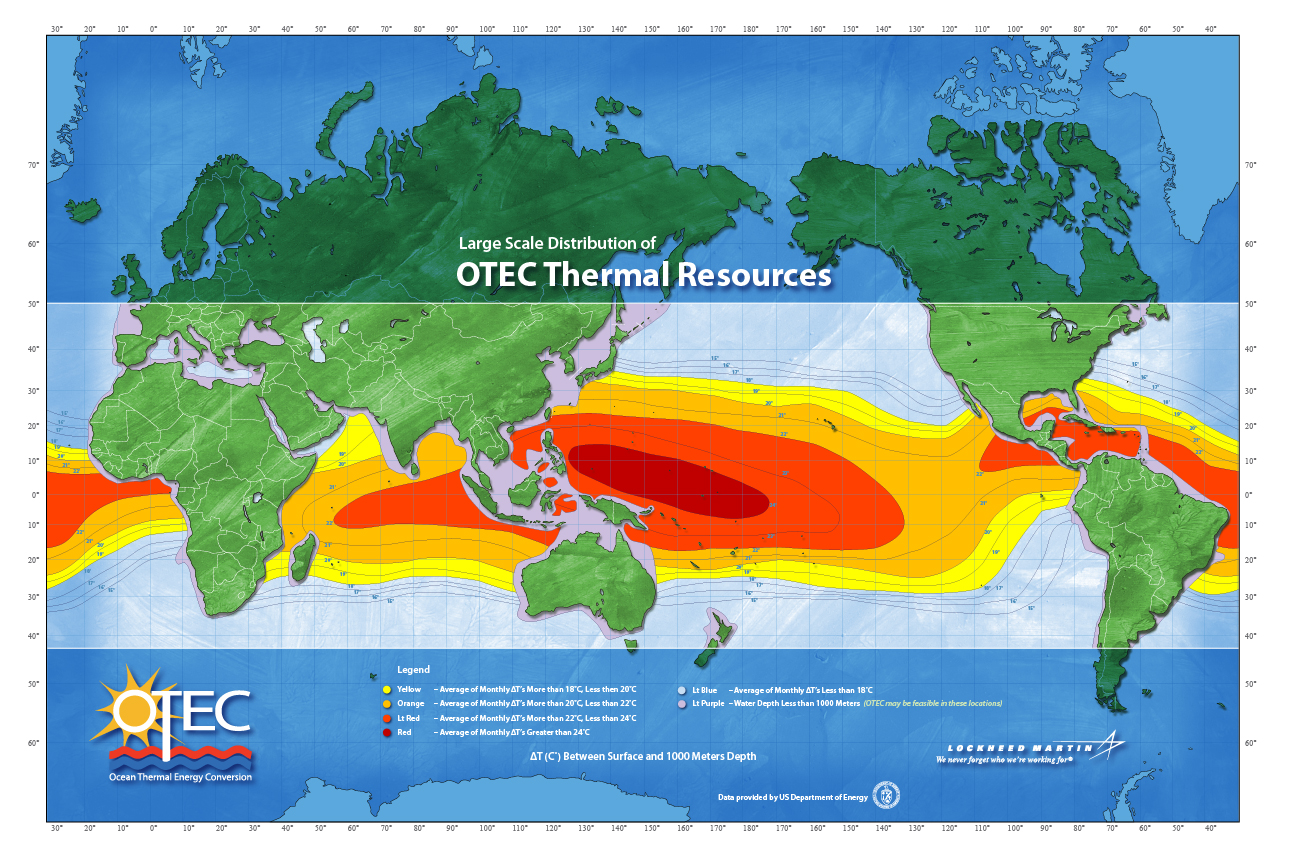How Lockheed Martin is using tropical waters to create clean energy

 In the last year, the U.S. Navy has awarded Lockheed Martin $12 million to advance the design for an Ocean Thermal Energy Conversion (OTEC) pilot plant off the coast of Hawaii. The plant will leverage the temperature difference between warm water on the surface and cold water below to produce renewable and reliable power.
In the last year, the U.S. Navy has awarded Lockheed Martin $12 million to advance the design for an Ocean Thermal Energy Conversion (OTEC) pilot plant off the coast of Hawaii. The plant will leverage the temperature difference between warm water on the surface and cold water below to produce renewable and reliable power.
OTEC plants use water to produce clean energy, 24/7, rain or shine. Not only are they an energy solution for fossil fuel-guzzling Pacific islands, but they will also help the Navy meet renewable energy goals. In addition, Lockheed is working on OTEC technology under a couple smaller contracts for the Department of Energy.
I recently spoke with Chris Myers, vice president for Energy and Government Programs for Lockheed Martin, about the benefits of OTEC and how it works.
I know Lockheed began work on OTEC in the ‘70s, but what’s the history since then?
In the ‘70s when oil prices spiked, there was some interest in renewable energies. But then there was a hiatus as prices went back down. Over the last few years we’ve seen renewed interest in OTEC and other renewable energies.
There are a couple companies out there [working on OTEC]. I think we’re probably in the lead in this. We have several activities going on. We have technology contracts from the Department of Energy and from the Department of the Navy to take a look at designing a prototype plant off the coast of Hawaii.
The prototype plant you built in the ‘70s, which was successful in generating more power than what was required to sustain it--is it functional today?
Mini-OTEC, which is in Honolulu, is not at sea. It took water from the ocean and demonstrated the technology on shore. It’s not being used right now.
Will you explain in how OTEC works—creating power from the differential between warm and cool water?
We have a long cold water pipe that goes deep in the ocean. Using a Rankine cycle [a steam-operated heat engine model] with the cold and hot water, you can produce electricity. You can think about it as an oil rig. It has heat exchangers.

So it's sitting in the middle of the ocean producing power. Does it matter what the weather is?
Not really. The weather is not a factor per se. You need a temperature differential, so that drives you to certain areas of the world. In the Pacific around Hawaii, Guam, Japan, Taiwan--that temperature differential works perfectly for OTEC.
What’s involved in setting up a plant, in terms of cost and time?
One of the things we’re gong to do with the pilot plant is to get all that knowledge and then we’ll know the price of the energy.
How much energy will the pilot provide?
From pilot plant, 5 to 10 megawatts. After that, we’re looking at 100 megawatts generating capacity.
What are the advantages to using OTEC?
- It’s all renewable; there’s no fossil fuel activity;
- It’s 24/7 renewable power;
- It can be backed up far away offshore so there’s no visual issues;
- It uses appropriate resources where it makes sense; instead of force-feeding solar or bio, it’s a technology that fits for island nations, especially ones that are dependent on oil, like Hawaii.
How many OTEC plants do you think we might have in the next 10 to 20 years?
Hawaii, Guam could have a number of them. There’s no limit. But my position is that energy diversity is a good thing. Put in some OTEC plants, bio plants, solar plants. I don’t like to put all your eggs in one basket. Any of our solutions are part of the whole solution. It’s a portfolio solution.
Who will OTEC’s customers be?
Generally it would be a utility or a private developer, but it could also be the U.S. government. The naval base, for example, could say we want to build a power plant.
What are some of the inherent challenges of designing a plant to go in the middle of the ocean?
We’re big fans of budgeting pilot plants for anything new. For example, we build a lot of radars, and we always build a radar demonstrator. One of the challenges when you're bringing cold water up through a pipe, you want to build in risk reduction, so you do technology risk reduction. Then you design the piece parts into a plant and go build that plant. There’s not one issue that is a particular challenge.
You’re under contract to design a plant for the Navy. What exactly are you doing for them?
We’re doing all the design work that’s required to build a pilot plant. We’re looking at the cost of energy, how is the technology going to come together, what are the environmental impacts. After all that, then they can say they are ready to build. We’re looking to get it fully funded. We just got a $4 million contract, so hopefully the next step will be building it.
More on Lockheed Martin:
- Lockheed Martin on the smart grid: ‘440 million new hackable points’
- Lockheed Martin: mobile microgrid will help save troops’ lives
- Lockheed Martin explores uncharted territory in sustainability
- Next NASA Mars mission gets go ahead; Lockheed Martin to build spacecraft
This post was originally published on Smartplanet.com